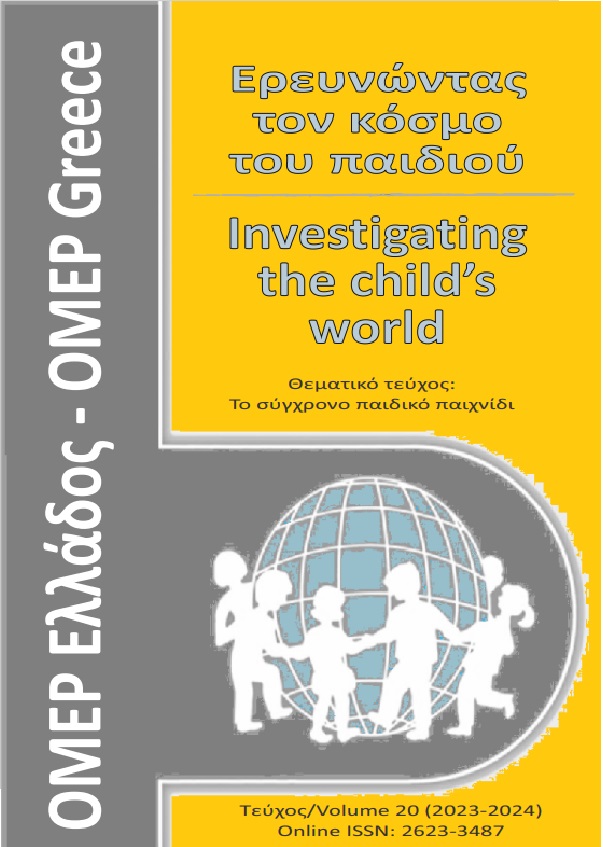Ρίσκο και Υπαίθριο παιχνίδι: δυνατότητες και ευκαιρίες
Resumen
Τα τελευταία χρόνια και ειδικά μετά την πανδημία, πολλοί ερευνητές και επαγγελματίες υπογραμμίζουν τη σημασία του υπαίθριου παιχνιδιού στην ολιστική ανάπτυξη και ευημερία των παιδιών. Ο πλούσιος πολυαισθητηριακός χαρακτήρας της βιωματικής μάθησης σε εξωτερικά ή υπαίθρια περιβάλλοντα παρέχει πολύτιμες δυνατότητες μέσα από τις οποίες τα μικρά παιδιά μπορούν να εξερευνήσουν πτυχές του εαυτού τους, των άλλων και του κόσμου γύρω τους. Στην παρούσα εισήγηση θα γίνει αναφορά στα οφέλη του υπαίθριου παιχνιδιού, στην παιδαγωγική του αξία, στον ρόλο των συμμετεχόντων και στα χαρακτηριστικά του υπαίθριου χώρου. Ιδιαίτερη αναφορά θα γίνει στο ρίσκο ως απαραίτητο συστατικό του ‘είναι και του γίγνεσαι’ και στο πώς το υπαίθριο παιχνίδι, και όχι μόνο, μπορεί να αποτελέσει ένα ασφαλές πεδίο μέσα στο οποίο τα παιδιά μπορούν να δοκιμάσουν τις δυνατότητές τους, να τολμήσουν και να ξεπεράσουν τα όριά τους. Πρόκειται για εμπειρίες που συντελούν στη διαμόρφωση προσωπικοτήτων με αίσθημα ευθύνης, αυτονομίας, αυτο-εκτίμησης και συνειδητοποίησης.
Article Details
- Cómo citar
-
Νικηφορίδου Ζ. (2024). Ρίσκο και Υπαίθριο παιχνίδι: δυνατότητες και ευκαιρίες. Ερευνώντας τον κόσμο του παιδιού, 20, 101–104. https://doi.org/10.12681/icw.35486
- Sección
- Επιστημονική αρθρογραφία & εκπαιδευτικές δράσεις

Esta obra está bajo una licencia internacional Creative Commons Atribución-NoComercial 4.0.
Οι Συγγραφείς που δημοσιεύουν εργασίες τους σε αυτό το περιοδικό συμφωνούν στους παρακάτω όρους:
Οι Συγγραφείς διατηρούν τα Πνευματικά Δικαιώματα και χορηγούν στο περιοδικό το δικαίωμα της πρώτης δημοσίευσης ενώ ταυτόχρονα τα πνευματικά δικαιώματα της εργασίας προστατεύονται σύμφωνα με την Creative Commons Attribution License που επιτρέπει σε τρίτους - αποδέκτες της άδειας να χρησιμοποιούν την εργασία όπως θέλουν με την προϋπόθεση της διατήρησης των διατυπώσεων που προβλέπονται στην άδεια σχετικά με την αναφορά στον αρχικό δημιουργό και την αρχική δημοσίευση σε αυτό το περιοδικό.
Οι Συγγραφείς μπορούν να συνάπτουν ξεχωριστές, και πρόσθετες συμβάσεις και συμφωνίες για την μη αποκλειστική διανομή της εργασίας όπως δημοσιεύτηκε στο περιοδικό αυτό (π.χ. κατάθεση σε ένα ακαδημαϊκό καταθετήριο ή δημοσίευση σε ένα βιβλίο), με την προϋπόθεση της αναγνώρισης και την αναφοράς της πρώτης δημοσίευσης σε αυτό το περιοδικό.
Το περιοδικό επιτρέπει και ενθαρρύνει τους Συγγραφείς να καταθέτουν τις εργασίες τους μέσω διαδικτύου (π.χ. σε ένα ακαδημαϊκό καταθετήριο ή στους προσωπικές τους ιστοσελίδες) πριν και μετά από τις διαδικασίες της δημοσίευσης, καθώς αυτό μπορεί να οδηγήσει σε παραγωγική ανταλλαγή ιδεών και σκέψεων καθώς επίσης και σε γρηγορότερη και μεγαλύτερη χρήση και ευρετηρίαση της δημοσιευμένης εργασίας (See The Effect of Open Access).



